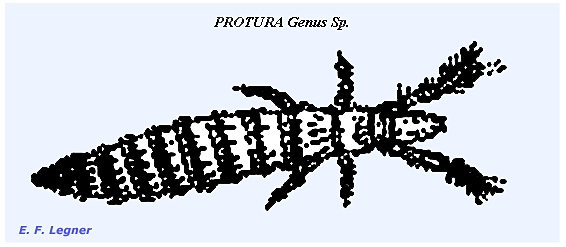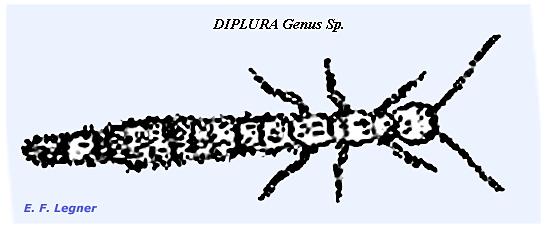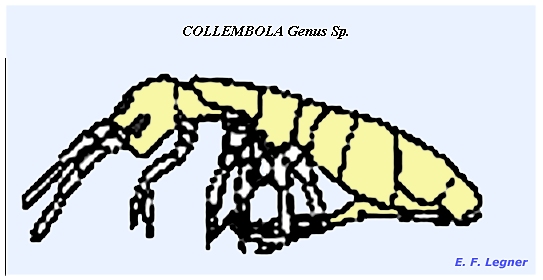File:
<entognatha.htm> <Index to Invertebrates> <Bibliography> <Glossary> Site Description <Navigate to Home>
|
Invertebrate
Zoology Kingdom: Animalia, Phylum: Arthropoda Subphylum: Hexapoda, Class: Entognatha (Contact)
CLICK on underlined file names and included illustrations to
enlarge: The Entognatha
is a class of arthropods that along with the Insecta comprises the
Hexapoda. Their mouthparts are entognathous
or retracted within the head. They
are apterous. Three orders are the
Diplura, Protura and Collembola.
These orders were previously included with the Insecta. All members are tiny arthropods
that no longer possess wings, although their ancestors are thought to have
been winged. They are found in moist
environments. Their mouthparts are
contained within a pocket in the head
capsule so that only the tips of the mandibles and maxillae are visible. They possess styli, which are vestigial
abdominal legs. There is no
tentorium, no external genitalia and only a one-condyle articulation of the
mouthparts. A tracheal system is also
lacking. The individual segments of the
antennae bear muscles, unlike the Insecta where only the two lower segments
are musculated. Sperm transfer is always indirect
and there is an ovipositor in the female. Orders of Entognatha Protura.
-- The cone heads lack antennae and eyes.
Their mouthparts consist of a labrum,
labium, mandibles and
seven maxillae that have been modified to rods, all recessed into the head.
They have abdominal styli that are believed to be vestigial legs. [Illustrations: PROTURA
]. Diplura.
-- The forked tails have antennae present.
Their maxilla is differentiated into a galea and a lacinia. All their mouthparts are also recessed
into the head. They also have a pair
of caudal cerci that has given them their name [Illustrations: DIPLURA ]. Collembola.
-- The springtails and snow fleas have antennae present. The mouthparts are recessed, and only the
Collembola have eyes even thought they have lost their function in most
species. When compound eyes are
present they have no more than 8 ommatidia.
Springtails are found under rocks and on the ground, etc., in the
springtime when they are most active. [Illustrations: COLLEMBO]. Springtails emerge before snow
melts, often blanketing the surface.
Their mouthparts are largely chewing.
The abdomen is developed into six segments, which is a decided reduction
in the normal number found in insects.
They possess a collophore or
ventral tube on the first abdominal segment, which is able to absorb
moisture. This is essentially a glue
peg, which is modified from abdominal legs.
It allows the animal to stick to surfaces. They also have a tenaculum on
the third abdominal segment, which is a hook modified from abdominal
legs. A furcula is
present on the fourth abdominal segment.
This allows for the "spring" of the springtail. It bends forward and hooks with the
tenaculum. Springtails are of some economic
importance in alfalfa fields (Lucerne flea),
in home gardens and for the mushroom industry. Along the Mississippi
River at Minneapolis they are very destructive to mushroom culture that
is located in caves along the banks of the river. ============== |


